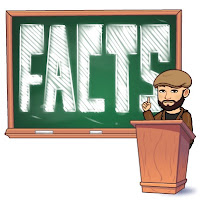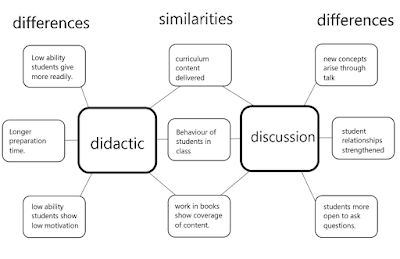Graham Chisnell
In developing a culture of research at Veritas MAT, I have been thinking about how we can best support our staff team in analysing their qualitative data by using visual representations. Adapting the use of Thinking Maps we use with pupils, we can help the researcher to filter their thoughts as they analyse their findings.
 Mind Maps were popularised by Tony Buzan who developed the use of mind maps to categorise learning. Here is an example of the chap himself inside a mind map.
Mind Maps were popularised by Tony Buzan who developed the use of mind maps to categorise learning. Here is an example of the chap himself inside a mind map.Thinking Maps were developed by David Hyrle and Yeager in 2007 for use in schools to help students to reason and recall. They involve a range of map templates that help students to develop thinking. Here are some examples from a Lyndsay Pryslak.
The first strategy to use in analysing your data is the
constant comparative method. This is used when you have collected evidence in
words and don’t want to convert the data to numbers through further analysis. This
process involves reading through the evidence collected and comparing
similarities, differences and anomalies to spot patterns in the words. The researcher
is encouraged to read their data over and over to compare and contrast and
allow the information to come together to present patterns of information they can
analyse.
Analysis of words in your evidence base
 Gary Thomas once again provides a helpful checklist for the
researcher analysing written evidence. I have simplified this in these steps:
Gary Thomas once again provides a helpful checklist for the
researcher analysing written evidence. I have simplified this in these steps:
1. Read through your written data.
2. Mark up your data, highlighting points of
interest, similarities across the data, make notes about parts you find
relevant or interesting.
3.
Draw initial thoughts together linked to your
research question from your first read through.
4.
Use your initial thoughts or emerging findings
to re-read the data to seek for further patterns relating to this.
5.
Make notes of key patterns and helpful quotes
from the data that can be used to answer your research question.
6.
Draw out the key themes from your analysis and
map these out and illustrate this with the quotes you have highlighted.
Mapping out your findings
Creating a visual map of your analysis of written evidence
can help your researcher to visualise the patterns in their analysis. There are
a few ways this can be done, let’s look at these.
Concept maps
I first came across thinking maps when lecturing in primary
education at Canterbury Christ Church University in the late 1990s. My students
were grappling with how to make effective notes and I used the mind maps of Tony Buzan (Buzan, The Mind Map Book, 2009) to help them to
connect their thinking during lectures. This process looked at recording key
words, images or ideas and making connections through link arrows to define how
these ideas were interrelated.
David Hyrle (Hyerle, 2011) took Buzan’s idea of
the concept maps and applied this to structure a range of thinking maps. These
maps can also be really helpful when analysing written data. Here are a few.
Flow map
 The flow map helps the researcher to define the cause and effect
within their research. The researcher will have reviewed the raw data and if
there is a clear sequence of consequences from their data, this can be recorded
in a flow map. A teacher researching the impact of the introduction of a new
retrieval practice initiative in history could record their analysis using this
template. The teacher’s research question is ‘Does retrieval practice affect pupil’s
confidence in geography?’ Each new action leads to a new observation in the
study over the course of three terms. Each term the teacher introduces a new
element of the strategy and reflects on the impact the has on the pupil’s perceived
confidence. The map produced is shown here.
The flow map helps the researcher to define the cause and effect
within their research. The researcher will have reviewed the raw data and if
there is a clear sequence of consequences from their data, this can be recorded
in a flow map. A teacher researching the impact of the introduction of a new
retrieval practice initiative in history could record their analysis using this
template. The teacher’s research question is ‘Does retrieval practice affect pupil’s
confidence in geography?’ Each new action leads to a new observation in the
study over the course of three terms. Each term the teacher introduces a new
element of the strategy and reflects on the impact the has on the pupil’s perceived
confidence. The map produced is shown here.Double Bubble Map
A double bubble map allows the researcher to compare and
contrast two things. For example, a researcher may be pursuing the research question,
‘How does teaching style effect student motivation in history?’. Their
observations have been recorded in narrative form and the researcher has also
used discussion with staff and pupils using the pyramid method. In reading
through the narratives, the researcher uses the bubble map to map out the similarities
and differences between the motivation of students to a didactic textbook-based
approach to teaching as opposed to a discussion-based approach. The double
bubble could look like this:
The researcher has used this double bubble to start to focus
on the key similarities and differences they have noted in the written data. With
this clarity, the researcher is now in a position to draw together their
analysis of their key findings.
Tree map
The purpose of the Tree Map is to help the researcher classify
their findings into key branches. This does not help the researcher consider
the interconnectivity of their findings, but helps clarify the grouping or
common threads to their findings. An example of this would be seen in a research
question, ‘What are the most effective strategies to encourage reading at home
for my reluctant readers?’. The researcher may have used The Pyramid as a
strategy to speak with students and hidden voices by sharing this also with parents,
a questionnaire to survey the pupils in their class and discussions with colleagues
across schools to review thoughts, feelings and actions further. The reading through
of the evidence base then led to the following summary in a Tree Map.
The researcher can then unpack the common themes drawn from
the evidence base. This researcher then went on to produce a second Tree Map
outlining the main themes from the parent’s response. This allowed the
researcher to compare and contrast the two viewpoints in their research
analysis. The invaluable insight to how both parents and pupils of reluctant
readers responded led to a strengthening of practice to support this group of
pupils to increase their confidence and motivation to read.
And finally...
When thinking about analysing your qualitative data, you can use these maps to help crystallize your thinking and use them to present your key findings by seeking for similarities and differences and points of interest in your evidence base.



